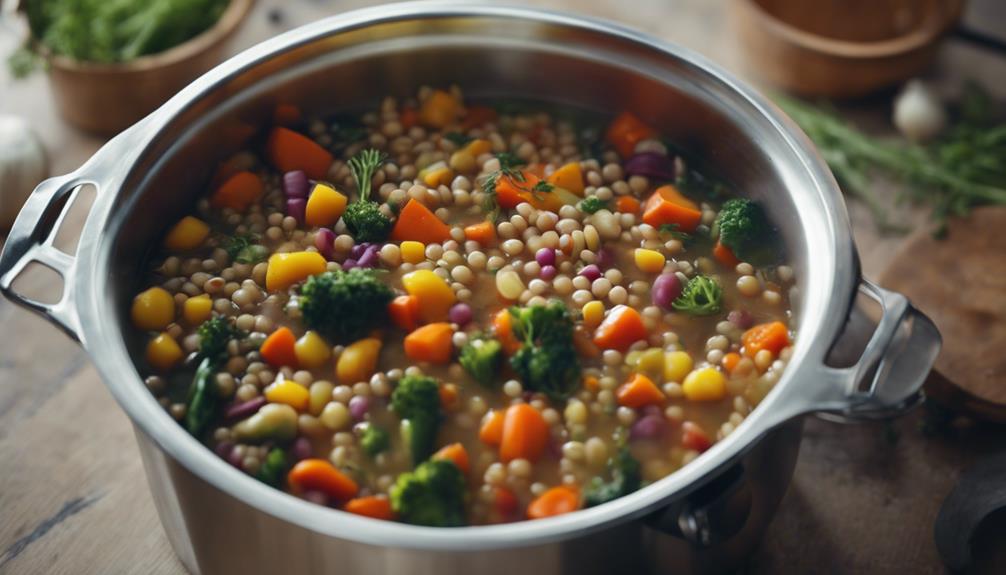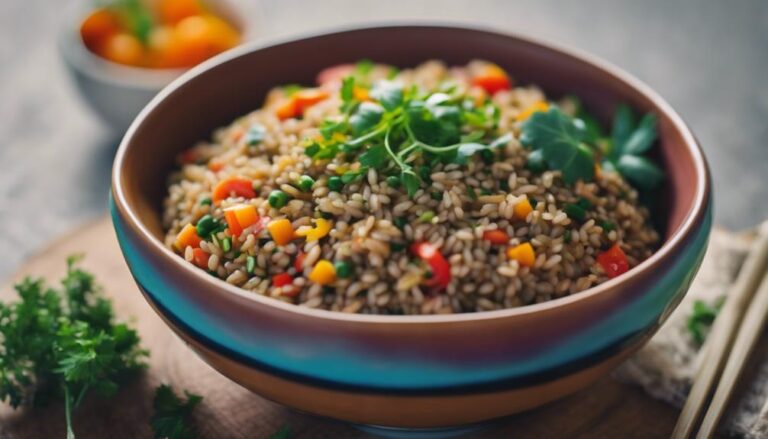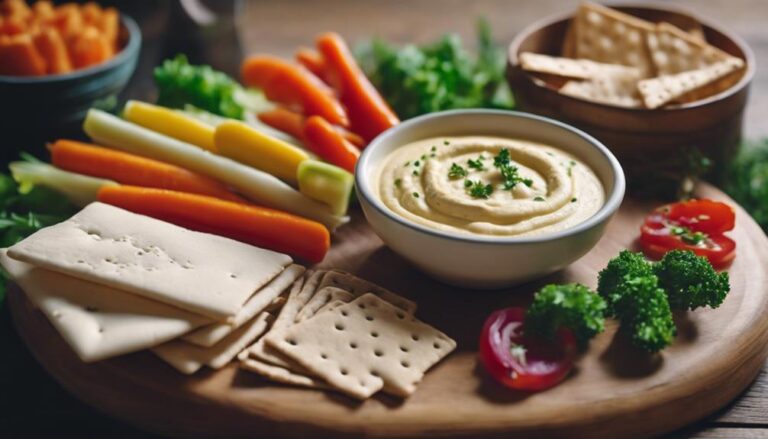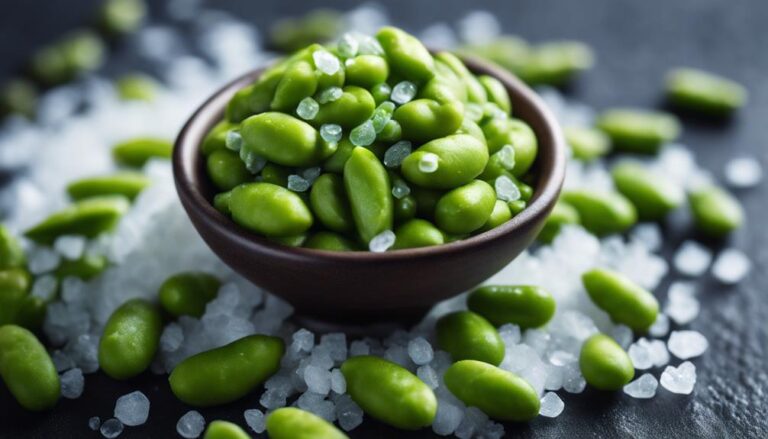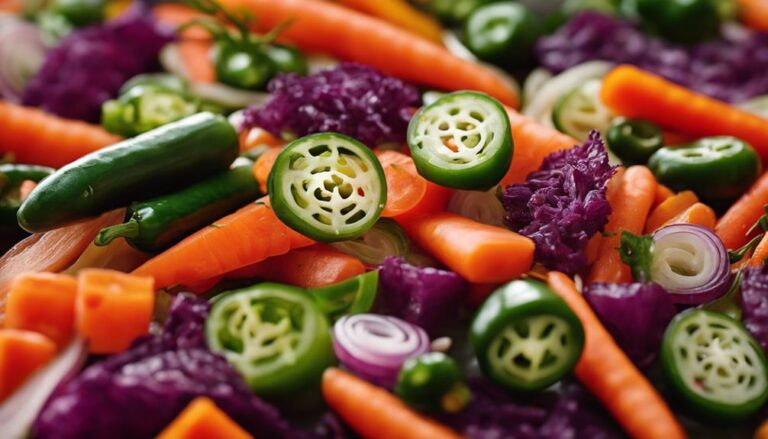Sous Vide Vegetable Stew With Pearl Barley
Step into a world where succulent vegetables and pearl barley dance in a sous vide vegetable stew. Immerse yourself in the vibrant flavors and tender textures that this dish offers. The pearl barley adds a hearty nuttiness, perfectly complementing the sous vide-cooked vegetables. Discover a vegan-friendly meal packed with fiber, vitamins, and minerals. Crafted with care, this stew showcases carefully selected herbs and spices, enhancing its taste and aroma. Each bite is a symphony of flavors waiting for you. Reveal the secrets of this culinary delight and uncover a world of enticing possibilities.
What You Will Learn Here
- Pearl barley adds hearty texture and nutty flavor to the stew.
- Vegetables cooked to perfection using sous vide techniques.
- Carefully selected herbs and spices enhance taste and aroma.
- Vegan-friendly dish rich in fiber, vitamins, and minerals.
- Customizable ingredients and toppings for a personalized touch.
Barley's Ancient Culinary Roots

Travel back in time to ancient civilizations where barley graced the tables of the Egyptians and Greeks, showcasing its enduring culinary significance.
Explore the diverse cooking techniques that have evolved over centuries to reveal the grain's potential in creating hearty dishes.
Uncover the nutritional treasure trove that barley offers, from its fiber-rich goodness to a plethora of essential vitamins and minerals.
Barley in Ancient History
In ancient culinary history, barley stood as a crucial grain, woven intricately into the fabric of daily sustenance for civilizations spanning millennia. Ancient civilizations like the Egyptians and Sumerians revered barley for its hardy nature and nutritional benefits, relying on it as a staple food.
Barley's versatility shone through as it was used to create a variety of culinary dishes, from bread to porridge and even fermented beverages like beer. The Greeks and Romans also embraced barley, incorporating it into their cooking with admiration for its richness and health benefits.
Through its rich history in ancient civilizations, barley emerged as an essential ingredient, showcasing its significance in the culinary world and as a key source of sustenance.
Barley Cooking Techniques
Ancient culinary traditions cleverly incorporated barley into a myriad of dishes, showcasing its versatility and nutritional prowess throughout history.
When it comes to cooking techniques, toasting barley before adding it to a stew can amplify its nutty flavor, bringing a depth that complements vegetable-based dishes perfectly. The process involves heating a dry pan and stirring the barley until it turns golden brown and releases a rich aroma.
This simple step enhances the overall taste of the stew, creating a more intricate flavor profile. By mastering this technique, you can unleash the full potential of barley in your culinary creations, honoring its ancient culinary roots while satisfying your taste buds with every nourishing bite.
Barleys Nutritional Value
Delving into the nutritional profile of barley reveals a wealth of benefits that have sustained civilizations for millennia. Barley, especially pearled barley, isn't only a key ingredient in hearty vegetable stews but also a powerhouse of nutrients. Packed with fiber, vitamins, and minerals, barley supports a healthy diet while being lower in calories than many other grains, aiding in weight management.
Its forgiving nature in the cooking process allows for versatile culinary applications, enhancing dishes with its nutty flavor. When toasted, barley's depth of flavor intensifies, adding complexity to meals like the sous vide vegetable stew with pearl barley.
Embrace the ancient culinary roots of barley and savor its nutritional richness in every hearty bite.
Barley Varieties in Stew
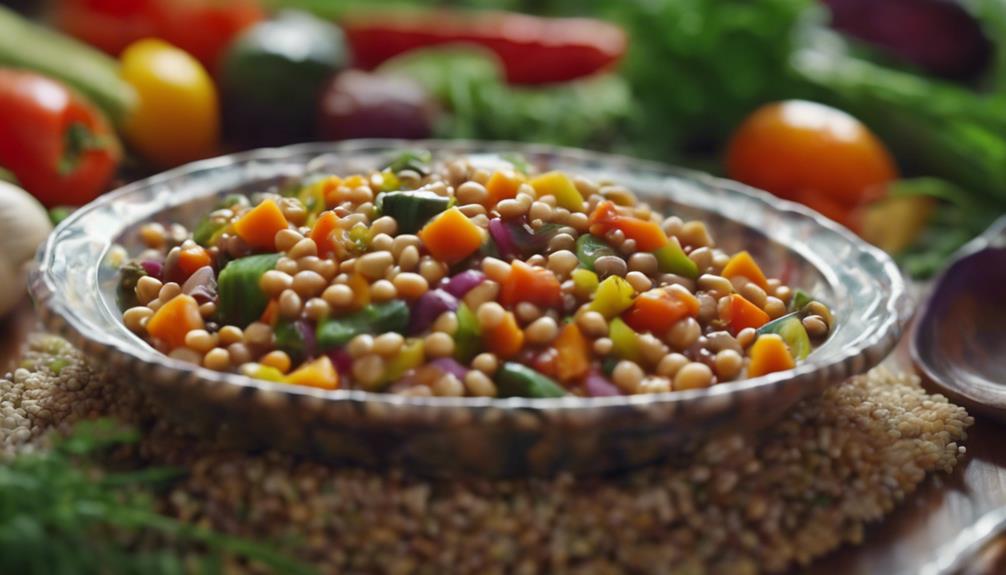
Within a rich vegetable stew, the selection of barley varieties plays a pivotal role in determining the dish's texture and nutritional content. Here are three key barley varieties commonly used in stews:
- Pearled Barley: This is the most popular type of barley for stews due to its quicker cooking time. It undergoes some bran removal, making it softer and faster to cook, but it also reduces some of its nutritional value compared to other varieties.
- Hulled Barley: Retaining more of its bran and germ, hulled barley offers a chewier texture and higher nutritional value. It takes longer to cook but provides a heartier and more nutrient-dense addition to your stew.
- Barley Flakes: These are partially cooked and flattened barley grains, offering a quick-cooking option for stew recipes. They can add thickness and a subtle nutty flavor to the stew while still retaining some nutritional benefits.
Experimenting with these different barley varieties can significantly impact the overall taste, texture, and nutritional benefits of your vegetable stew.
Barley Stew Variations
You're about to commence on a tantalizing journey through the world of barley stew variations.
From the rich flavors of Blackford Farm's Sous Vide Stew to the comforting simplicity of a Hearty Vegan Barley Stew, there's a diverse array of options to explore.
Consider trying out a wholesome Barley and Lentil Stew for a hearty and nutritious meal that's bound to satisfy your taste buds.
Blackford Farm's Sous Vide Stew
Exploring the diverse barley stew variations at Blackford Farm through the lens of sous vide cooking offers a culinary adventure that enhances traditional comfort food to new levels of sophistication and flavor.
- Innovative Technique: Blackford Farm's sous vide stew combines red lentils, pearl barley, and vegetable broth, creating a rich and hearty base with tender ingredients.
- Inspired Simplicity: Drawing inspiration from Heidi Swanson's blog, 101 Cookbooks, the stew's straightforward yet delicious combination showcases the natural flavors of the grains and vegetables.
- Customization Options: The Anova Sous Vide Precision Cooker provides precise temperature control, resulting in consistently tender stew. Personalize your bowl with various toppings, vegetables, or spices to tailor the flavors to your liking.
This sous vide stew from Blackford Farm promises a delightful and customizable dining experience.
Hearty Vegan Barley Stew
Enhancing the essence of hearty vegan cuisine, the barley stew variations offer a vibrant tapestry of flavors and textures to elevate your dining experience.
- Flavorful Vegetables: Incorporate a mix of seasonal vegetables like carrots, celery, and bell peppers to add freshness and depth to your vegan barley stew.
- Customizable Pearl Barley: Experiment with different types of pearl barley such as quick-cooking or hulled barley to find the perfect chewiness for your stew.
- Herby Dumplings: Elevate your stew with herby dumplings made from a blend of fresh herbs like rosemary and thyme, adding a burst of aromatic flavors with every bite.
These variations will turn your vegan barley stew into a comforting and satisfying dish that's both nourishing and delicious.
Barley and Lentil Stew
The fusion of tender barley and hearty lentils creates a robust stew brimming with wholesome goodness and rich flavors. When preparing a barley and lentil stew using sous vide techniques, consider the following:
- Ingredient Options:
- Swap red lentils and brown rice for barley to add a nutty flavor and chewy texture.
- Experiment with different vegetables like carrots, celery, and tomatoes to enhance the stew's depth.
- Sous Vide Precision:
- Utilize the Anova Sous Vide Precision Cooker for a hassle-free cooking process that guarantees even heat distribution.
- Customization Ideas:
- Personalize your stew by incorporating spices such as cumin or paprika for an extra kick of flavor.
- Top your barley and lentil stew with fresh herbs like parsley or cilantro for a finishing touch.
Barley Soaking Technique
Before you start cooking, consider the benefits of soaking barley; it reduces cooking time and enhances texture. Remember, soaking for at least 30 minutes or overnight is ideal for the best results.
Benefits of Soaking Barley
Soaking barley before cooking not only reduces preparation time but also enhances its nutritional value and digestibility. By softening the grains and breaking down complex carbohydrates, soaking barley helps decrease cooking time. This process also boosts nutrient absorption and improves the texture of the grain, making it tender and less chewy. Additionally, reducing phytic acid content through soaking enhances digestibility. Enzymes released during soaking promote gut health and aid in digestion. This traditional method has been utilized for centuries to enhance the cooking process and elevate the nutritional benefits of barley.
| Benefits of Soaking Barley | |
|---|---|
| Reduces cooking time | Enhances nutrient absorption |
| Improves texture | Promotes gut health |
| Enhances digestibility |
Importance of Soaking
Consider submerging the barley in water prior to cooking to enhance its texture and shorten the cooking time considerably. By soaking barley, you can break down phytic acid, making it easier for your body to digest and absorb essential nutrients.
This process not only improves the texture of the barley, resulting in a softer and more evenly cooked grain but also helps in removing any debris or impurities. Overnight soaking is recommended for best results, but even a few hours can make a significant difference in the cooking process.
Soaking Time Recommendations
Enhancing the texture and flavor of your vegetable stew with pearl barley involves optimizing the soaking time to achieve a creamy consistency and reduce overall cooking time to a great extent. When soaking pearled barley, consider the following recommendations to improve your dish:
| Soaking Time | Benefits |
|---|---|
| 4-8 hours | Reduces cooking time and enhances texture for a creamier consistency. |
| Overnight | Maximizes flavor absorption and aids in digestion for better nutrient absorption. |
| 1-2 hours | Quick soaking methods for those short on time, still reducing cooking time effectively. |
| Boiling water | Speeds up the soaking process, ensuring the barley is ready to enhance your stew quickly. |
Final Thoughts
As you reflect on the delightful blend of flavors and textures in this sous vide vegetable stew with pearl barley, consider the endless possibilities for creating a truly satisfying and nutritious meal. The pearl barley, with its hearty texture and nutty flavor, adds a wholesome element to the stew, complementing the tender vegetables cooked to perfection through sous vide techniques. The carefully selected herbs and spices not only elevate the taste but also infuse the dish with enticing aromas, making each bite a sensorial experience.
This vegan-friendly dish isn't only a treat for the taste buds but also a powerhouse of fiber, vitamins, and minerals, ensuring a well-rounded and nourishing meal. The beauty of this recipe lies in its adaptability; you can customize the ingredients and toppings to suit your preferences, allowing for a personalized touch to every serving. Whether you're a seasoned chef or a home cook looking to impress, this sous vide vegetable stew with pearl barley is sure to delight and satisfy with its harmonious medley of flavors and wholesome ingredients.
Frequently Asked Questions
Does Pearl Barley Thicken Stews?
Yes, pearl barley is a fantastic thickening agent for stews. When cooked, it releases starch into the liquid, creating a creamy texture and thickening the stew's consistency. Its ability to absorb liquid and expand enhances the overall flavor profile.
Do I Need to Soak Pearl Barley Before Cooking?
You don't need to soak pearl barley before cooking. Its quick cooking time and softer texture eliminate the need for soaking. Enjoy the convenience of preparing meals without this extra step. Save time and savor the flavorful results.
Can You Overcook Pearled Barley?
You can overcook pearled barley, affecting its texture, flavor absorption, and nutritional value. Monitoring cooking time is vital to avoid mushiness. Enjoy a vegetarian option with perfectly cooked barley for a delightful dining experience.
What Is the Ratio of Water to Pearl Barley?
To achieve the perfect balance in your stew, remember the 1:3 water to pearl barley ratio. It's key for proper cooking time and flavor absorption. Adjust for texture preferences and enjoy the nutritional benefits of this versatile ingredient.
Conclusion
As you take a leisurely sip of the rich vegetable stew with pearl barley, the tender vegetables and hearty grains mingle together in perfect harmony.
The sous vide method has truly elevated this classic dish to new heights, infusing every bite with flavor and tenderness.
With each spoonful, you savor the ancient culinary roots of barley, grateful for its versatility and nourishing qualities.
This sous vide vegetable stew with pearl barley is a comforting and satisfying meal that will leave you feeling warm and fulfilled.
Enjoy every last drop!
